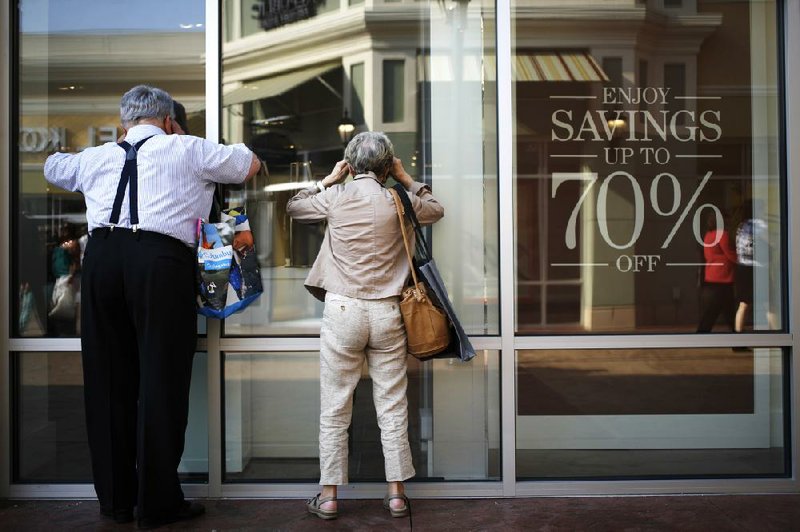WASHINGTON -- U.S. consumer spending rose at the fastest pace in three months in June, providing momentum for the economy going into the second half of the year.
Consumer spending increased 0.4 percent in June on a seasonally adjusted basis after slower increases of 0.3 percent in May and 0.1 percent in April, the Commerce Department said Friday.
That was the best showing since a 0.8 percent surge in spending in March, which reflected a rebound after a harsh winter had kept consumers from the malls and auto showrooms.
Consumer spending is closely watched because it accounts for two-thirds of economic activity.
The report was one of four economic reports released Friday. U.S. construction spending fell in June by the largest amount in more than three years as housing, nonresidential construction and government spending all weakened, the Commerce Department reported. The Institute for Supply Management, a trade group of purchasing managers, said its manufacturing index rose to 57.1, up from 55.3 in June. Anything above 50 signals that manufacturing is growing.
The Labor Department said employers added 209,000 jobs in July, but the unemployment rate rose to 6.2 percent as more people began looking for jobs.
Americans saw earnings rise 0.4 percent in June, matching the May increase, according to the consumer spending report. Income growth has lagged in this recovery but has shown recent signs of some acceleration.
Paul Dales, a senior U.S. economist at Capital Economics, said the strong gains in employment during the past six months should support stronger consumer spending in the second half of this year. He predicted that consumer spending will increase at an annual rate of 3 percent in the next six months, an increase from a more modest 2.3 percent average growth rate in spending over the past two years.
A key measure of inflation favored by the Federal Reserve increased a modest 0.2 percent in June, slightly below the 0.3 percent May increase. Over the past 12 months, this measure of inflation is up 1.6 percent, still below the Fed's target of 2 percent but above the lows of the past two years. Excluding food and energy, prices are up an even slower 1.5 percent during the past 12 months.
The absence of inflationary pressures has given the Fed the leeway to focus on keeping interest rates at low levels to foster stronger job growth although this inflation gauge has moved up from the lows of the past two years.
Construction spending dropped 1.8 percent in June on a seasonally adjusted basis after rising by a revised 0.8 percent in May, the Commerce Department said. It was the biggest setback since a 2.8 percent fall in January 2011.
The weakness was widespread with spending on housing down for a second straight month, falling 0.3 percent, while nonresidential building activity fell 1.6 percent, the biggest decrease since January. Spending on government projects dropped 4 percent, the biggest decline in more than a decade.
The June performance represented a setback to hopes stronger construction activity will support overall economic growth.
The decline in housing reflected a 1.4 percent fall in spending on single-family construction which offset a 2.5 percent rise in the smaller apartment sector. Even with the two months of declines, housing construction is still 7.4 percent above the level of a year ago.
The drop in nonresidential activity reflected weakness in hotel construction and the category that includes shopping malls. Nonresidential building is 11.2 percent higher than a year ago.
The 4 percent fall in government projects was the biggest one-month setback since government building tumbled by 6 percent in March 2002. The June weakness reflected a 5.2 percent decline in state and local government projects, which offset a 10.4 percent rise in spending on federal building projects.
The Institute for Supply Management's manufacturing index expanded for the 14th straight month in July in a good sign for the overall economy.
"Manufacturing's growing pretty solidly," said Jim O'Sullivan, chief U.S. economist at High Frequency Economics in Valhalla, N.Y. "The backdrop for consumer spending looks positive with the labor market improving. Capital goods orders have strengthened. And the housing recovery, while it's been choppy, does seem to be getting back on track."
The U.S. economy already has been showing renewed strength. Economic growth clocked in an impressive 4 percent annual pace from April through June after getting off to a bad start the first three months of the year. And the Labor Department said Friday that employers added more than 200,000 jobs in July for the sixth straight month. Factories created 28,000 jobs in July, the most since November. In the past year, manufacturers have added 178,000 jobs, best 12-month stretch of hiring since November 2012.
Information for this article was contributed by Martin Crutsinger and Paul Wiseman of The Associated Press and by Michelle Jamrisko of Bloomberg News.
Business on 08/02/2014
